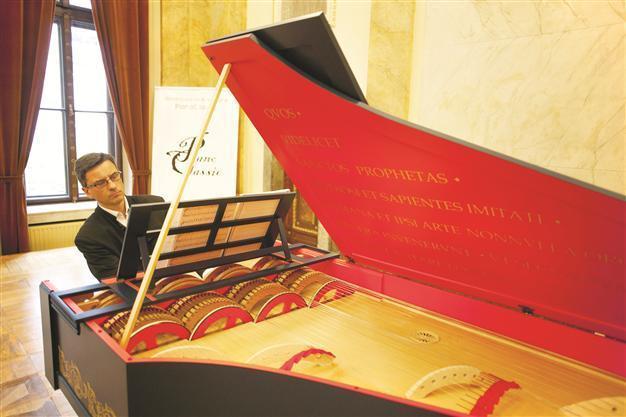Pianist brings life to Da Vinci’s piano
KRAKW, Poland - The Associated Press

Polish concert pianist Slawomir Zubrzycki presents an extremely rare Viola Organista, based on a late 15th-century design by Leonardo da Vinci.
With elegant black and tan keys it looks like a baby grand piano, but when tinkled they release the voluptuous tones of a cello.Painter of the Mona Lisa, Italian Renaissance genius Leonardo da Vinci also dreamt up the Viola Organista in the late 15th century as a marriage of keyboard and string instruments. But he never built it, experts say.
Virtually forgotten, it has come to life thanks to a Polish concert pianist with a flair for instrument-making.
Full of steel strings and spinning wheels, Slawomir Zubrzycki’s creation is a musical and mechanical work of art. “This instrument has the characteristics of three we know: the harpsichord, the organ and the viola da gamba,” Zubrzycki said recently as he debuted the instrument at the Academy of Music in Poland’s historic southern city of Krakow.
“Leonardo da Vinci invented it around 1470-80,” said 50-year-old as he rummaged in a briefcase full of tools picking one for a final tuning.
The instrument’s exterior is painted in a rich hue of midnight blue adorned with golden swirls painted on the side. The inside of its lid is a deep raspberry inscribed with a Latin quote in gold leaf by 12th-century German nun, mystic and philosopher, Saint Hildegard. “Holy prophets and scholars immersed in the sea of arts both human and divine, dreamt up a multitude of instruments to delight the soul,” it says.
Four spinning wheels
The flat bed of its interior is lined with golden spruce. Sixty-one gleaming steel strings run across it, similar to the inside of a baby grand. Each one is connected to the keyboard complete with smaller black keys for sharp and flat notes. But unlike a piano, it has no hammered dulcimers. Instead, there are four spinning wheels wrapped in horse tail hair, like violin bows. To turn them, Zubrzycki pumps a peddle below the keyboard connected to a crankshaft.
As he tinkles the keys, they press the strings down onto the wheels emitting rich, sonorous tones reminiscent of a cello, an organ and even an accordion.
The effect is a sound that da Vinci dreamt of, but never heard; there are no historical records suggesting he or anyone else of his time built the instrument he designed.
















